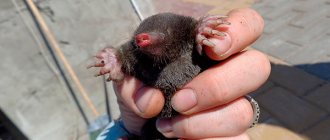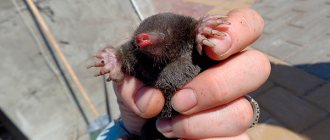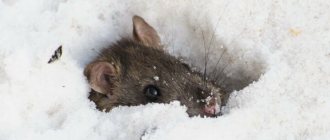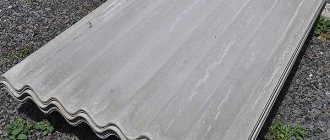With the arrival of the first warm weather, gardeners have more worries. Preparing and pruning trees, digging up soil, applying fertilizers – there’s a lot of work to be done. The main task is to prepare the soil as much as possible for planting seedlings and clean the garden from pests. But if mole crickets and butterflies are still far away, then rats, mice, and moles wake up with the first rays of spring and go in search of food.
Many beginners tend to underestimate moles, the benefits of which are very questionable. But it is these cutest little animals that are able to “shovel” an area and turn it into a “minefield” overnight.
Doesn't like root vegetables
Let's start with the fact that moles have nothing to do with rodents, since they are representatives of another order - insectivorous mammals. Mice and rats are not related to them at all, and closer relatives of moles are shrews, hedgehogs and bats. This immediately closes the question of gnawing on carrots or beets. Although sometimes they can actually gnaw the roots if their intricacies become an obstacle on the underground path. But garden plants do not die from such minor damage to the underground parts. It’s worse if you dived seedlings into open ground, and a mole corridor passed right under them. You arrive at the dacha, go to the garden, see the withered tops of seedlings, run for a watering can, water the withered plantings, and they... immediately fall into an underground passage washed away by the stream.
Article on the topic Mole, go away! Rating of means to combat uninvited guests
Feeding features of moles
Before you start fighting small pests, you need to consider what moles eat in the garden and what food is most attractive to them. Moles are small insectivorous animals that, both in nature and in the garden, feed on the same food - insects.
Moles have a miniature digestive system and a very fast metabolism, due to which it takes no more than 3-5 hours to completely digest food. That is why animals are almost always in search of food.
In a day, a mole can eat an amount of food corresponding to its weight, and without food it cannot live longer than 18 hours.
The mole is constantly looking for food and storing it for the winter - this is why he tears up the soil in his summer cottage. During the day, the animal builds up to 25 new passages in search of food. In this case, the network of dug labyrinths can cover an area of up to 40-50 m. Entrances and exits to the burrow can be identified by molehills - small hummocks of earth.
Worm Eater
The main food of underground hunters is earthworms and, to a lesser extent, other invertebrates and their larvae. The mole digs a whole system of underground passages with holes and storerooms, and in certain places breaks an exit hole to the surface, which helps regulate the flow of air and ventilates the underground dwelling. That's where these mounds in the soil come from. Certain glands on the animal’s body secrete odorous substances that are attractants for earthworms. Attracted by this smell, they crawl into the mole corridors and inevitably fall into the teeth of a voracious predator. The mole does not eat all the prey; it gnaws other worms in half and takes them to cool storerooms, from where they cannot crawl.
Thus, there is help - a lot of pests and their larvae are on the menu of moles, and at the same time, significant harm - worms are necessary for our soils, without them productivity drops significantly.
Country moles - who are they?
The animal's body length is about 15 centimeters, and its weight is 130 grams. The mole carries out its life activity and nutrition underground, digging tunnels in the soil.
The insectivore can make its nest at a depth of two meters, which makes it invulnerable to humans. In a day he is able to dig through an entire network of multi-tiered passages.
The constant movement of the animal requires replenishment of energy, so it eats a lot. Without food, moles do not live long - only 15 hours. The main diet of the animal is earthworms, caterpillars, and larvae of harmful insects. Moles do not live in swampy soils and soils with a high groundwater content. They are attracted to loose, dry soils.
The first signs of the appearance of a mole are soil thrown to the surface in the form of a hill, which interferes with work on the site.
Improves soil
The mole brings great benefits to your site. When making their moves, the animals loosen the soil well. As a result, it is saturated with oxygen, aerobic bacteria carry out the process of energy synthesis, and the composition of the soil improves. And a special “anti-mole” lawn net, which is buried horizontally in the soil, under the lawn turf, will help protect the soil from slides.
Another important argument in defense of moles: very often the blame is shifted onto them from the “shoulders” of rodents. If the mounds of molehills do not rise above the ground and the passages are dug at the very surface of the earth, then this is clearly the work of voles.
By the way
The main harm of moles is that they eat worms. Academician Vernadsky believed that earthworms created the fertile layer of the planet. They affect soil fertility. Worms eat organic matter, saturate it with useful substances and secrete it in the form of the most valuable fertilizer - coprolites.
War with the Mouse King: strategy and tactics Read more
Why you should never get rid of moles on your property: they are not your enemies, but your helpers
Moles form large cavities in the soil, improve air exchange in it and the absorption of rainwater during rainstorms
Photo: Shutterstock
Beginning summer residents sometimes step on the same rake. For example, beds are dug up too often. Or they overdo it with watering. They forget about fertilizing, pruning, and weeding. And on top of that, they declare war on moles, sincerely believing that they are being eaten up by natural gifts. Brazenly. Cynically. For free. Moreover, they leave behind these ugly tubercles. The lawn looks like it was after a bombing.
Yes, that's what many people think.
However, competent gardeners tear these patterns into small pieces. They wash beardless gardeners like fifth graders. They chuckle condescendingly, crossing their arms with calluses on their chests.
Because moles on your land are irreplaceable helpers who work day and night for free. They don't work for you for a fee. And for the idea. They literally save your trees, fruit and berry crops. They are engaged in land reclamation.
Recently, one well-known agronomist, gardener, and landscape designer, Sergei Sidorenko, published another post that blew up the Internet (it would be nice to reproduce this text and drop it in batches from helicopters - over summer cottages and the private sector).
Let's try to highlight the main points.
1. Many people will probably be surprised, but moles do not eat roots and bulbs. At all. They are from the order of insectivores.
2. Moles form large cavities in the soil, improve air exchange in it and the absorption of rainwater during rainstorms. Just a couple of hours - and 20 cm of precipitation - without runoff! - they disappear somewhere. Later this water comes out as springs from molehills. And so, thanks to moles, the garden in the Krasnodar Territory does not need to be watered even in the heat.
3. The soil with these animals becomes more fertile. And it is moles (along with worms) who dig it, not humans. All that remains is to help with compost and use high mowing on the meadow lawn. As a result, coniferous trees grow by two meters, chestnut trees bear fruit in their fifth year, seedlings take root without watering, old apple trees and nuts increase their yield.
4. Moles maintain the population of earthworms by eating the weak, sick and surplus. They also deter slugs and beetles, which actually destroy plants.
5. Underground passages provide shelter for many small animals (these are wasps, ground beetles, shrews, and lizards), which also deter slugs and beetles. And many others.
HELP "KP"
Sergey Sidorenko, a native of Omsk, has been creating harmonious gardens for many years. Works in the Krasnodar region. And he is a supporter of a natural and sustainable ecosystem - without chemical treatments and mineral fertilizers. The soil is essentially cultivated by earthworms, insects, rodents, and moles. And it has a favorable porous structure. In the botanical garden “365”, where Sergei works, more than 700 species and varieties of plants from different parts of the Earth are cultivated. Studied at Omsk Agrarian University. Author of books, lectures and thematic publications. UN expert in the field of agriculture, permaculture and sustainable development. Married. Has five children.
THE MASTER OF THE EARTH IS THE MOLE, NOT YOU
In short, it was in vain that we rolled a barrel at the moles. They are, one might say, Stakhanovite heroes. And we, sir, curse them. Some even try to kill these animals. They put out rattles. Poison is poured into the holes. Ultrasonic repellers are installed.
“And none of these methods is effective,” ex-State Duma deputy and dacha guru Andrei Tumanov . - Unless a wire mole trap makes sense. But, believe me, getting rid of moles is obscurantism and stupidity. I've been talking about this for decades. And still there are people who attribute all sorts of gnawing to these animals. Listen. Moles are not vegetarians. And they are not omnivores, unlike rats. They consume all kinds of caterpillars. The very ones who want to leave you without a harvest. For that matter, the mole is not just your neighbor. He is the owner. He has lived here for thousands of years. And you came for a couple of days and decided to kick him out. Well, try it. Then we'll see how you fight the May Khrushchev. Who eats like a horse. Well, yes, sometimes moles destroy beds. They leave behind so-called hunting holes. But their benefits are much greater. Moreover. If you do get rid of the moles, others will sooner or later take their place.
Summer resident Tumanov agrees with agronomist Sidorenko on all points.
WITHOUT UNDERGROUND HORES, PLANTS ARE SMOKING
“If you don’t want earthen mounds to appear on your lawn, you can use a special polymer mesh,” agronomist Mikhail Vorobyov told KP . — It is laid to a depth of 25 cm. Then the earth is poured back. And on top there is a lawn. Moles will bump into an obstacle and avoid this place. But to drive them away completely, of course, is wrong. Who will eat the larvae of cockchafers? Who will destroy the mole cricket, a real nightmare of any gardener? What about wireworms that spoil potatoes? If you notice that someone is eating your carrots (or tulip bulbs, for example), do not blame the moles. This is done by either carbysh or field mice. Well, there’s one more significant plus. Long and durable earthen passages. During rainfall, they lose a lot of water. And in dry weather, which is also very important, air penetrates underground. Without it, the root system begins to suffocate. Organic matter does not decompose properly. And gleying occurs. The earth acquires a bluish tint and loses its fertile qualities.
BY THE WAY
Before the 1917 revolution, moleskin coats were popular in Russia. And they were very expensive. This animal has special fur. Nothing sticks to it. And some merchant could roll around drunkenly in the mud, then shake himself off and go to a meeting of the Russian Assembly. Or back to the restaurant. Such a fur coat cannot be called very warm. But very beautiful, noble, quite presentable. Under Soviet rule, such luxury was abandoned. Nowadays, the price for one such fur coat starts from 250 thousand rubles. And this is considered inexpensive, because one product requires approximately 500 animal skins.
Reviews from summer residents
Mikhail, 63 years old, Poltava
Every spring we always started fighting moles in our garden plot; we didn’t have the energy to look at the molehills near the fruit trees. We tried everything: traps and poisons, but it only had a temporary effect. Therefore, I decided to buy an ultrasonic device for repelling pests - “ Tornado OZV.01.” I bought three of them with a reserve, since on my site there are eight fruit trees with a powerful root system, a well and the foundation of a house that prevent vibrations from spreading in the ground. I dug in the repellers so that only the battery compartment cover remained outside. I placed them in the center of the site at an equal distance from each other, after which new molehills did not appear until the end of autumn. We dug up both carrots and potatoes safely.
Tamara, 46 years old, Nevinnomyssk
I want to share my experience of fighting this underground inhabitant. I made the trap with my own hands. The mole easily climbs into it, but cannot get out. The bottom is cut off from a 1.5 liter plastic bottle, then a second bottle of the same size is taken - the neck is cut off (the cap is screwed onto it), a “funnel” is left and the bottom is cut off. Then 10 longitudinal cuts are made in the second bottle until it becomes a flat part - it looks like long petals. Then the second bottle with its narrowed part is inserted into the open passage of the first, and the joint is wrapped with tape. The mole trap is ready. I put it in a mole hole, and the animal falls into the trap through the entrance of the second bottle, but back against the narrowed petals and cannot get out. Many have already been caught like this.
Ruslan, 45 years old, Temryuk
I fight moles with traps. I pierce the ground around the molehill with a metal rod, then determine the direction of the moves and carefully place it in both directions. Then I close the cutout tightly. I catch about six per season. The process is labor-intensive, but reliable. You can’t get rid of moles forever in this way, but a drop wears away the stone.
Animal repellers
Experts are sure that these animals simply cannot tolerate loud sounds. This is why many gardeners recommend using various types of mole repellers. They give a fairly good result, but it is worth remembering that the animal may return over time.
Special devices, for example, ultrasonic repellers such as Bioguard and Chiston, can create discomfort for shrews. They are buried in the ground. It is worth remembering that they have a fairly low power, so they may not give any result.
Such a device makes a sound that is unpleasant for animals and scares away all rodents located within a radius of 20-30 meters. Among the disadvantages of mole repellers, it should be noted that such devices need to be located throughout the area. In addition, they have a fairly high cost.
Among the sound repellers, firecrackers should also be highlighted, since this is a fairly effective way to combat moles, and in addition, it has a low cost. Many gardeners claim that after using this method, animals do not appear on the site for several seasons. To do this, you need to dig up a mole hole, throw a lit firecracker into it and cover the exit with your foot. As a result, a dull underground explosion occurs. A similar procedure must be repeated with each hole.
You can make a repeller yourself. To do this, take an empty plastic bottle without a cap. You need to stick an iron rod deep into the ground and put a bottle on it. When the wind blows, the plastic will begin to make unpleasant sounds, which the mole’s auditory organs cannot withstand, and the animals leave this place.
You can dig empty glass bottles into the ground, neck up, at a slight angle, so that about 10 cm remains above the ground. The wind will blow into the neck, and the bottle will make an unpleasant whistle.
Among the main advantages of using repellent devices, one should highlight the maximum ease of use combined with the absence of the need for contact with the rodent itself. However, there are also certain disadvantages of repellers, since it is not possible to predict in advance how effective this remedy will be.
Repelling moles does not always happen very quickly and effectively, since even the best devices help get rid of the animals in at least 1-2 weeks. In addition, it is not always possible to accurately determine whether the animal has left the area or not. Thus, it is advisable to use deterrents even before catching moles, as an experiment.
Using traps
Many people are interested in how to drive moles out of the area quickly and efficiently so that they do not cause trouble. Manufacturers offer to simultaneously use different models of traps that belong to the same type. They are small pipes with covers on both sides. These devices are quite inexpensive and do not give practically any results, since often the animals simply do not go into an unfamiliar object that has appeared on the site.
You can purchase slightly larger traps so that their design is the same in diameter as the animal’s burrow, and the walls are rough. Thanks to special valves, it is possible to easily keep the animal inside. There are many varieties of such traps, in particular:
- tunnel traps;
- mole trap pipes;
- live traps;
- plunger devices.
When used correctly, you can quickly and effectively get rid of these animals in the garden. Traps are also good because they give a clear, visible result that immediately becomes obvious. Their main disadvantage is the complexity of installation, since you need to dig out the mole's passages. It is also important that it will be necessary to regularly catch animals that periodically appear on the site.
Live traps work on a very simple principle, since the animal easily gets into them and cannot get out. There are ready-made products, but you can easily make a trap yourself. You can use plastic water pipes or bottles for this. In addition, a pit trap can be used, which is a wide bottle or glass jar located under the mole's path. The animal simply falls into it and cannot get back out.
In addition, you can use traps that simply kill the mole, but this is not very good, since the animals do not cause much harm.
Aggressive methods
As radical measures, chemicals, traps, traps and molebreakers are used. Each method has its own advantages and disadvantages.
Chemicals
They are very toxic, so it is necessary to work only in protective clothing, gloves, goggles and a mask (respirator). The drug is poured into the mole duct. However, you should take care in advance about pets and farm animals that roam freely around the site, since most products are toxic not only to moles.
Traps, traps, molebreakers
A trap is a mechanical device designed to catch animals. However, not everyone copes with the responsibilities assigned to her. For the fight to be effective, the trap must meet several requirements:
- have a diameter corresponding to the underground tunnel through which the animals move;
- the inner walls should feel like earth to the touch;
- have a reliable locking mechanism.
Otherwise, a mole, which has a good sense of touch and smell, can simply bypass a suspicious mechanism on its way.
Traps are effective, but inhumane to fauna, devices. They are placed in underground tunnels and masked with earth. However, if there is strong vibration, they may operate idle. This should be taken into account by owners whose property is located near a road, or whose children often frolic in the garden. Although in reality there can be much more situations that can provoke vibration.
Mole traps are a type of trap. Electronic devices equipped with special sensors are considered the most effective.











